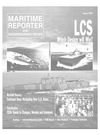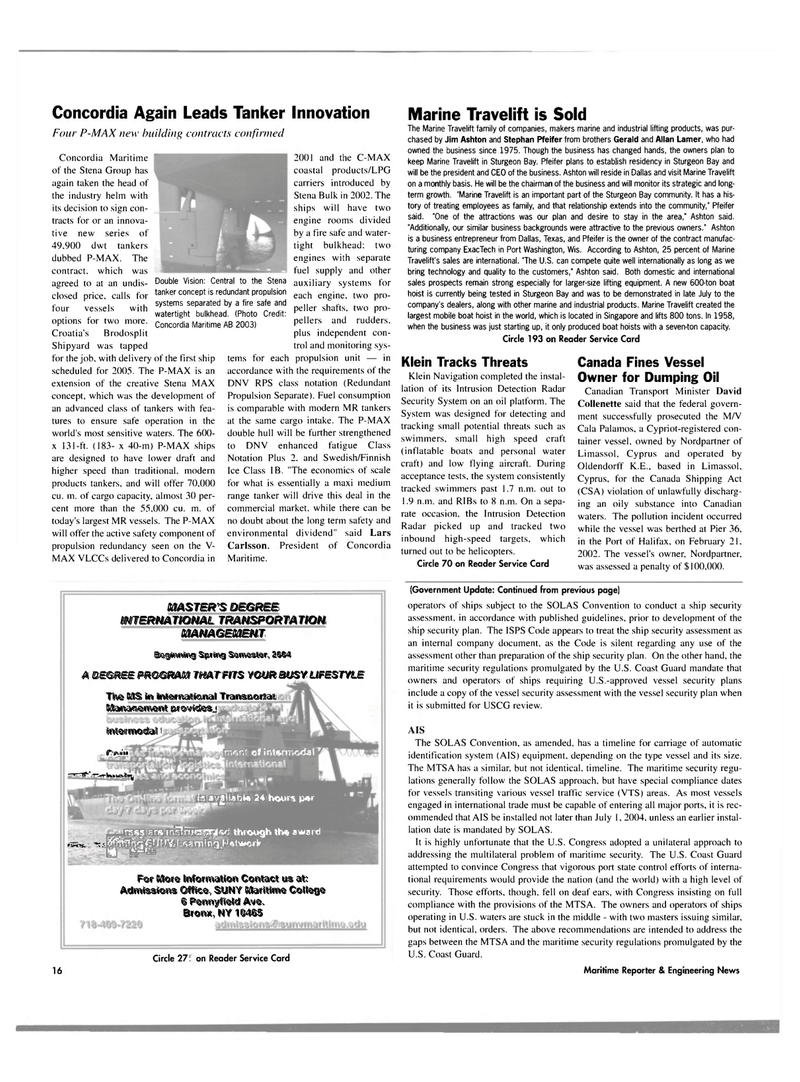
Page 16: of Maritime Reporter Magazine (August 2003)
Read this page in Pdf, Flash or Html5 edition of August 2003 Maritime Reporter Magazine
Concordia Again Leads Tanker Innovation Marine Travelift is Sold
Four P-MAX new building contracts confirmed
Concordia Maritime of the Stena Group has again taken the head of the industry helm with its decision to sign con- tracts for or an innova- tive new series of 49,900 dwt tankers dubbed P-MAX. The contract, which was agreed to at an undis- closed price, calls for four vessels with options for two more.
Croatia's Brodosplit
Shipyard was tapped for the job, with delivery of the first ship scheduled for 2005. The P-MAX is an extension of the creative Stena MAX concept, which was the development of an advanced class of tankers with fea- tures to ensure safe operation in the world's most sensitive waters. The 600- x 131 -ft. (183- x 40-m) P-MAX ships are designed to have lower draft and higher speed than traditional, modern products tankers, and will offer 70.000 cu. m. of cargo capacity, almost 30 per- cent more than the 55.000 cu. m. of today's largest MR vessels. The P-MAX will offer the active safety component of propulsion redundancy seen on the V-
MAX VLCCs delivered to Concordia in
Double Vision: Central to the Stena tanker concept is redundant propulsion systems separated by a fire safe and watertight bulkhead. (Photo Credit:
Concordia Maritime AB 2003) 2001 and the C-MAX coastal products/LPG carriers introduced by
Stena Bulk in 2002. The ships will have two engine rooms divided by a fire safe and water- tight bulkhead: two engines with separate fuel supply and other auxiliary systems for each engine, two pro- peller shafts, two pro- pellers and rudders, plus independent con- trol and monitoring sys- tems for each propulsion unit — in accordance with the requirements of the
DNV RPS class notation (Redundant
Propulsion Separate). Fuel consumption is comparable with modern MR tankers at the same cargo intake. The P-MAX double hull will be further strengthened to DNV enhanced fatigue Class
Notation Plus 2. and Swedish/Finnish
Ice Class IB. "The economics of scale for what is essentially a maxi medium range tanker will drive this deal in the commercial market, while there can be no doubt about the long term safety and environmental dividend" said Lars
Carlsson. President of Concordia
Maritime.
The Marine Travelift family of companies, makers marine and industrial lifting products, was pur- chased by Jim Ashton and Stephan Pfeifer from brothers Gerald and Allan Lamer, who had owned the business since 1975. Though the business has changed hands, the owners plan to keep Marine Travelift in Sturgeon Bay. Pfeifer plans to establish residency in Sturgeon Bay and will be the president and CEO of the business. Ashton will reside in Dallas and visit Marine Travelift on a monthly basis. He will be the chairman of the business and will monitor its strategic and long- term growth. "Marine Travelift is an important part of the Sturgeon Bay community. It has a his- tory of treating employees as family, and that relationship extends into the community," Pfeifer said. "One of the attractions was our plan and desire to stay in the area," Ashton said. "Additionally, our similar business backgrounds were attractive to the previous owners." Ashton is a business entrepreneur from Dallas, Texas, and Pfeifer is the owner of the contract manufac- turing company ExacTech in Port Washington, Wis. According to Ashton, 25 percent of Marine
Travelift's sales are international. "The U.S. can compete quite well internationally as long as we bring technology and quality to the customers," Ashton said. Both domestic and international sales prospects remain strong especially for larger-size lifting equipment. A new 600-ton boat hoist is currently being tested in Sturgeon Bay and was to be demonstrated in late July to the company's dealers, along with other marine and industrial products. Marine Travelift created the largest mobile boat hoist in the world, which is located in Singapore and lifts 800 tons. In 1958, when the business was just starting up, it only produced boat hoists with a seven-ton capacity.
Circle 193 on Reader Service Card
Klein Tracks Threats
Klein Navigation completed the instal- lation of its Intrusion Detection Radar
Security System on an oil platform. The
System was designed for detecting and tracking small potential threats such as swimmers, small high speed craft (inflatable boats and personal water craft) and low flying aircraft. During acceptance tests, the system consistently tracked swimmers past 1.7 n.m. out to 1.9 n.m. and RIBs to 8 n.m. On a sepa- rate occasion, the Intrusion Detection
Radar picked up and tracked two inbound high-speed targets, which turned out to be helicopters.
Circle 70 on Reader Service Card
Canada Fines Vessel
Owner for Dumping Oil
Canadian Transport Minister David
Collenette said that the federal govern- ment successfully prosecuted the M/V
Cala Palamos, a Cypriot-registered con- tainer vessel, owned by Nordpartner of
Limassol, Cyprus and operated by
Oldendorff K.E., based in Limassol,
Cyprus, for the Canada Shipping Act (CSA) violation of unlawfully discharg- ing an oily substance into Canadian waters. The pollution incident occurred while the vessel was berthed at Pier 36, in the Port of Halifax, on February 21. 2002. The vessel's owner, Nordpartner, was assessed a penalty of $100,000. (Government Update: Continued from previous page) operators of ships subject to the SOLAS Convention to conduct a ship security assessment, in accordance with published guidelines, prior to development of the ship security plan. The ISPS Code appears to treat the ship security assessment as an internal company document, as the Code is silent regarding any use of the assessment other than preparation of the ship security plan. On the other hand, the maritime security regulations promulgated by the U.S. Coast Guard mandate that owners and operators of ships requiring U.S.-approved vessel security plans include a copy of the vessel security assessment with the vessel security plan when it is submitted for USCG review.
Circle 273 on Reader Service Card 16
AIS
The SOLAS Convention, as amended, has a timeline for carriage of automatic identification system (AIS) equipment, depending on the type vessel and its size.
The MTSA has a similar, but not identical, timeline. The maritime security regu- lations generally follow the SOLAS approach, but have special compliance dates for vessels transiting various vessel traffic service (VTS) areas. As most vessels engaged in international trade must be capable of entering all major ports, it is rec- ommended that AIS be installed not later than July 1, 2004. unless an earlier instal- lation date is mandated by SOLAS.
It is highly unfortunate that the U.S. Congress adopted a unilateral approach to addressing the multilateral problem of maritime security. The U.S. Coast Guard attempted to convince Congress that vigorous port state control efforts of interna- tional requirements would provide the nation (and the world) with a high level of security. Those efforts, though, fell on deaf ears, with Congress insisting on full compliance with the provisions of the MTSA. The owners and operators of ships operating in U.S. waters are stuck in the middle - with two masters issuing similar, but not identical, orders. The above recommendations are intended to address the gaps between the MTSA and the maritime security regulations promulgated by the
U.S. Coast Guard.
Maritime Reporter & Engineering News m«nt; of intervnods I sssSissdauain
MANAGEMENT
S^immtagj Spring Semester., 2QM
A ©E The MS to iMwMfrmall Trawsftorttait
BtonaeifeiWieyiit Bftowtetesj
InHeitmodlall i
{T'ct*, u' a i
* asgi* i^ssa
fs avgftefcte 24 hours p*r
rsnz stc in.drtjcvfsg'^; through th« zwatri
j|$ffl||pJWSY Usmfns I '^worir
MASTER'S DEGREE
(INTERNATIONAL TRANSPORTATION
Fw Motte llwfoviiwaitSon Contest us art;
AMs&iims Office, SUINY Maritime College
% Pevmyfteld Ave,
Bronx, m 164S5

 15
15

 17
17
